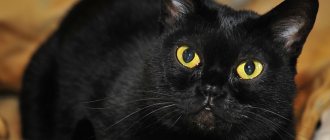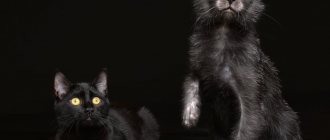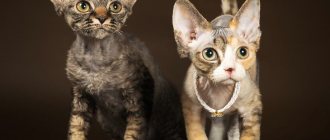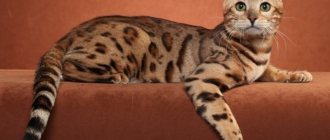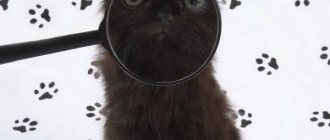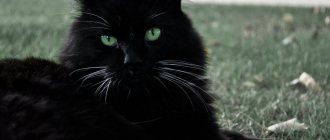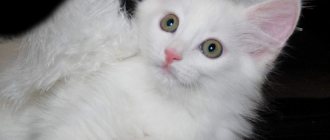History of the origin of the breed
The history of the origin of the bush cat is entirely due to evolution. The man went further and helped the serval hybrids to be born. But more on that later.
global $ads_google; //data-ad-slot=”2475549904″ $ads_google = empty($ads_google) ? false : true; ?> if ($ads_google == false) {?>
$ads_google = true; ?> } ?>
Servals live in Africa, except the Sahara Desert, in the forests of the equatorial zone and in the south, in the Cape Province. It is rare to see a wild serval near Algeria, Morocco. In Tanzania, in the Ngoro-Ngoro crater, there are a lot of these animals. About 40 representatives of the breed live there per 100 m2.
In the wild, animals settle near a source of water. Therefore, keeping the house turns into searching for water and playing with it. The animal greets the rain joyfully, then happily running its wet paws across the floor and beds. Ancestor genes!
Description and standards of servals
The predatory appearance is combined with grace. The head appears miniature against the background of the body. The nose is wide, which makes the serval look like a cheetah. The impression of similarity is disturbed by the large ears in comparison with the head.
The eyes are beautiful with their large almond shape. The eyes are light. There are a couple of black stripes on the muzzle, they stretch from the eye line. The cat always seems to be in a sad mood. This is a natural camouflage color.
The forelimbs are shorter than the hind limbs, which affects gait.
Powerful paws allow you to reach speeds of up to 80 km/h and jump up to 3 meters in height.
The tail of the African cat is short and quite thick: this is necessary so as not to interfere with hunting. Tail length 27-40 cm.
The standard is under development, so there is no strict description yet.
Cat colors
The spots on the coat are darker than the background coat itself. On the back, all the spots begin to merge into stripes, while on the chest, muzzle and stomach there may be no spots. On the contrary, cats in these places are whitish.
There is no variety of colors. If we look at the descriptions of different servals, we will see differences in the shades of the main coat color. These are variations within light sand and brown. Very rarely, a Serval cat can be black (melanistic) or white (albino). In nature, black color is the result of melanism, and snowball cats with silver spots are only the result of albinism.
The coat is short, thick, and the coat is silky to the touch.
Serval dimensions and weight
Not a small cat at all, if you compare it with other domestic cats. The body length is decent: 60-100 cm. At the withers, the animal reaches 60 cm. This is due to long limbs.
The weight of cats in adulthood usually reaches 16 kg. But animals can weigh more or less, within 10-18 kg. Females weigh slightly less than males of this breed.
Reproduction and lifespan
As the mating season approaches, male Cheetahs begin to track down lonely females, showing them all sorts of signs of attention. This behavior of males stimulates the onset of ovulation and estrus in females.
Most often, males cooperate at this time in small flocks, often consisting of relatives, mainly brothers.
Several groups may even fight with each other during the mating season. These fights are non-lethal, they are usually started in order to show off in front of their friends.
For a short period of estrus (about a week, sometimes two), a temporary pair is formed. The act of copulation itself occurs many times, but it is very short, no more than a minute.
Cheetahs have a very long gestation period - about three months. Such a long pregnancy is typical for large, not small cats, which, according to modern scientific classification, includes the Cheetah.
Usually the female chooses a large hole abandoned by a porcupine or fox. There, from two to six kittens are born. They are blind and absolutely helpless, making them easy prey for savannah predators and eagles.
Babies have a completely different color from adults. The bellies are covered with dark down, the fur is silvery on top, the mane on the back of the head is very fluffy, and there is a tassel at the tip of the tail.
Their appearance during this period resembles a honey badger. This is a predatory animal of the mustelid family, living in both Africa and Asia. It is often called the bald badger because of its peculiar color - it feels like a snow cape has been thrown over its dark, shaggy body. These are very aggressive and dangerous predators, biting even antelopes with their sharp teeth. They have virtually no natural enemies.
Thus, at an early age, nature mimics the Cheetah cub as a dangerous and ferocious honey badger, which helps at least partially save the offspring from death.
The tassel on the tail is also useful; it is used by a mother to find a baby lost in the bushes.
By three to four months, this peculiar coloring begins to change, the shaggy mane and tassel on the tail disappear. Babies begin to try solid food, but until eight months the mother continues to feed them milk.
Until one and a half to two years, adolescents live with their mother, being almost constantly under her control, they learn to hunt and defend themselves. Young Cheetahs owe their safety only to the female; they go through a real survival school with her. Thus, scientists have noted that kids who grew up in a zoo do not know how to sneak up and chase prey.
It is very interesting to watch how the brood eats with its mother: both the female and the babies never take pieces of meat from each other and behave very peacefully.
Sexual maturity in cheetahs occurs at 2-3 years.
The lifespan of this wild cat in its natural habitats is 15-30 years. In nature reserves or zoos, they can live much longer.
Hybrids
Since serval males are able to give birth to an ordinary cat, interesting hybrids are obtained. From the connection between the caracal and the serval, the servical (caraval) is obtained. When kittens are born from a relationship with a domestic cat, the hybrid is called “savannah”. There were separate reports that the Asherah was taken out in this way. The question is still under consideration whether this is a separate breed or a universally recognized Savannah. Most experts recognized Ashera as a savannah, but people did not stop buying it for fabulous sums.
global $ads_google; //data-ad-slot=”2475549904″ $ads_google = empty($ads_google) ? false : true; ?> if ($ads_google == false) {?>
$ads_google = true; ?> } ?>
Savannah began to be bred in the 80s of the last century, but associations recognized it only in 2001. The breed is not bred independently, because males obtained by crossing cannot produce offspring, and females that cross with domestic cats will, after several generations, produce offspring without Serval traits. Therefore, the price for the first generations is high and will not be reduced.
Servical (Ser-Caracal) is obtained by crossing a male serval and a female caracal. The result is babies that look like dad, but with tufts on their ears, like mom’s.
Caraval comes from a father caracal and a mother serval. As a result, the offspring looks like the mother, without ear tufts, and with a darker coat color.
Natural varieties of Cheetah
This unique predator has natural subspecies.
African subspecies
Four of them live in Africa:
- Acinonyx jubatus hecki, described by scientists only in 1913, is distributed throughout North-West Africa and the Sahara Desert.
- Acinonyx jubatus fearsoni, known in the scientific world since 1834, is found in areas of East Africa.
- Acinonyx jubatus jubatus, described back in 1775, is an inhabitant of southern Africa.
- Acinonyx jubatus soemmeringii, known to scientists since 1855, is an inhabitant of the northeastern regions of the African continent.
Asian subspecies
Only one Asian subspecies of Cheetah is found in the Middle East - Acinonyx jubatus venaticus; its scientific description dates back to 1821.
The Asian population is the smallest. Today, in the Iranian provinces of Markazi, Fars, and Khorasan, research scientists count only 60-70 individuals of this rare predator. Although it is possible that solitary animals may still live on the territory of Afghanistan and Pakistan.
The eastern variety of the predator is not too different from the African one. The animal has slightly shorter limbs, a wider and more powerful neck and chest, and its skin has been considered the thickest and most durable since ancient times.
The decline in populations in the Middle East is associated with a global decrease in the food supply. Due to human activity, the number of ungulates has decreased significantly. The poaching hunt for the beautiful skin of the predator also continued.
King Cheetah
Another interesting variety of Cheetah is known - the Royal. It has an unusual and very beautiful color.
This is a natural color mutation. The animal has bright coal stripes along the entire ridge, and the black spots on the sides are much larger.
This animal was first discovered in 1926 and was initially thought to be a hybrid species resulting from an accidental cross between a cheetah and a serval. Genetic tests confirmed the purity of the variety.
Initially, the bright mutant was identified as a separate subspecies Acinonyx rex. The scientific debate ended in 1981, when a bright “royal” cub was born from a pair of ordinary predators. This happened in Africa.
These animals, when crossed with African or Asian subspecies, produce full-fledged offspring, but the “royal” color does not appear in all cubs, since a recessive gene is responsible for it.
Other Cheetah Color Mutations
Among these unique wild cats, sometimes, as a result of uncontrolled natural mutations, completely black individuals are born - melanistic cheetahs. At first glance, their color is absolutely charcoal, but in bright lighting you can replace the usual spots.
Cases of albinism, that is, the birth of a completely white baby, also occur, but they are extremely rare.
Scientists also identify another color mutation – red. These animals have a bright golden background, with spots of reddish tones scattered across it.
It is noted that in semi-deserts and deserts the coloring of Cheetahs is less expressive and faded, which makes the predator less noticeable against the background of the sands.
Extinct subspecies
Cheetahs descended from the very ancient predator miacida, like other representatives of the cat family and canines.
What miacid looks like (left)
Specifically, the genus of Cheetahs almost completely disappeared after the Ice Age, but the “bottleneck” effect worked.
With this term, scientists describe the process of a sharp reduction in the gene pool during critical periods of development. At the same time, natural factors begin to work, changing the relative and absolute frequencies of gene alleles, as a result of which the necessary mutations occur that allow the animal population to survive. This is one of the most important postulates of evolution.
Today's population of Cheetahs on earth is a prime example of such a process.
It has been established that these animals have very little genetic diversity, which suggests that during the last global catastrophes of the planet, most likely, one pair of individuals survived, which are the ancestors of all Cheetahs existing today. Now animals have reduced vitality, increased sensitivity to pathologies, and a decline in fertility. There is a high mortality rate among cubs; as a result of constant inbreeding, even half of the newly born animals do not survive until the end of the first year of life.
Cheetahs are quite different in their morphology from other representatives of the cat family. Indeed, they are more like dogs.
Read the article review of the entire cat family.
At the beginning of the last century, they were even united into a separate family, but later, due to some similarity in structure with Pumas and a sharp reduction in numbers, they were added to the small cats.
Scientists today know four extinct subspecies of Cheetahs:
- Acinonyx aicha;
- Acinonyx intermedius;
- Acinonyx kurteni;
- Acinonyx pardinensis.
The latter was called the European Cheetah and lived on the territory of modern Europe.
Cheetah without spots
Characteristics of servals
A wild cat that becomes a domestic cat leaves behind a funny character. The cat will show it in all its glory, these will be unforgettable years of coexistence between a spotted bush cat and a human.
The animals have not lost their genes anywhere: they happily hang on any ropes, curtains, or cords. The owner's job is to secure the house.
The serval kitten will happily chew on everything that his gaze falls on. To avoid problems with chewed things, the baby is given a sufficient number of toys.
It's funny, but this pet reacts negatively to apple spray from the pet store. If a little serval boy looks with interest at things not intended for him, the spray will immediately dull this interest.
The character of the pet can be called cunning. If he crosses boundaries, this must be stopped. Stop playing if he bites your hand hard at this time. The cat is smart, the correct conclusions will still be drawn.
Since childhood, a kitten has been playing with any cat toys; as they grow older, they are replaced with dog toys; they are larger and will not get into the respiratory tract.
The serval is dexterous and evasive. It's fun to play with him, but if the cat suddenly shows anxiety, you need to be patient. The pet will learn to feel safe with its owner. You can play tug and fetch.
Cats react negatively to the torture that small children may subject them to. It is important here that the owner does not allow such situations to occur. The pet will remain calm, and no one will scratch the children in fear. If children do not offend the cat, then the relationship with him will be friendly.
This unthreatening predator will most likely be afraid of guests and hide from them. Well, don’t insist, the cat’s healthy psyche is much more important. As soon as the pet gets used to other people's voices and smells, he himself will show curiosity and come out to look at the strangers.
Since in nature cats feed on small rodents, birds and reptiles, and there are already such pets in the house, introductions should be done carefully and gradually. It’s better to think and weigh who you want to keep in the house more. A smart serval will open the latch on the cage with the bird, but not to ask how it is doing. With an affectionate dog that does not chase cats, a good relationship can develop.
It is better to bring a small cat to a house where pets already live. This option will allow you to hope for the emergence of friendship between all the inhabitants of the house or apartment.
Raising and training a pet
To ensure that upbringing goes smoothly, a kitten is purchased no earlier than 1.5 months, but no later than 5 months. It is best to hand feed your baby; this will build trust in the person.
You need to accustom your cute savage to a leash and collar from childhood. At first they offer a loose collar, but gradually tighten it tighter.
The Serval is active and cannot be left unattended in a collar and leash even for a minute! This poses a risk of suffocation
Accustom kittens to wood filler in a tray. They will not bury their litter box, so you will have to keep the tray clean. If the cat went to the toilet in a place other than the litter tray, there is no need to scold it. They immediately explain where to go. The animal understands the dissatisfied tone perfectly well.
global $ads_google; //data-ad-slot=”2475549904″ $ads_google = empty($ads_google) ? false : true; ?> if ($ads_google == false) {?>
$ads_google = true; ?> } ?>
If your pet climbs onto the table or misbehaves, you can spray it with a water pistol. This will be a serious warning!
Peculiarities of Cheetah behavior
Cheetahs have a lot from dogs, not only in appearance, but also in behavior and physiological characteristics. So, these predators sit and lie just like dogs. They often suffer from “canine” diseases.
Their hunting style is in no way reminiscent of a cat's. After all, all representatives of this large family prefer to take a wait-and-see attitude and attack the victim suddenly, killing him in one motion, biting the back of the head. Cheetahs, like dogs, always chase their prey, jumping on its back and trying to bite its neck.
Despite this, they really are cats. It’s just that they and dogs had a common ancient predator ancestor, and the Cheetah, unlike its relatives, retained many of its features.
The color of the animal’s skin is clearly “tabby”, characteristic only of the cat family. The structure of the paws is the same; their tracks cannot be confused with any other predator. Only cats have five toes on their front paws and four on their back paws.
Cheetahs, like all cats, are excellent at climbing rocks and trees, although they prefer to hunt on the ground.
The structure of the claws also characterizes the Cheetah as a true cat. They are large, with sharp, curved tips. Moreover, babies climb trees much better, but in adults, as a result of a long run on hard or rocky soil, the claws are worn down. In terms of their hardness, they are still not inferior to iron, and a blow from a paw with open claws, for example, is fatal for many representatives of artiodactyls.
Up to 3-4 months, Cheetah kittens can retract their claw completely into their toe pads, like all members of the cat family, but with age they lose this ability. The position of the toes is more reminiscent of a dog's paw. It is this fixation that helps the Cheetah run so fast.
This amazing wild animal is capable of making many sounds, but it definitely cannot bark. They meow, although it is more like an iridescent chirp, they snort, hiss and even purr, like all cats. This is explained by the special structure of the larynx, characteristic only of this family.
The Cheetah cannot roar like a lion. The hyoid plate in small cats is completely ossified and cannot vibrate.
The cheetah is not aggressive towards its relatives; its nature in nature can be called rather soft and peaceful.
When the animal is relaxed, well-fed, and contented, it begins to rumble and purr like an ordinary domestic cat.
The Cheetah is not aggressive towards humans either, although it avoids them. On African safaris, people have repeatedly noted that the predator can calmly walk nearby, absolutely not being frightened by the close presence of tourists, or even jump on the hoods of cars and look at people with interest.
Cheetahs, unlike other wild cats, cannot be called night hunters. They can chase prey at any time of the day. More often this happens during the day, when herds of antelopes or other ungulates come out for walking or watering.
Hunting takes place in open areas and the predator has no opportunity to hide.
The cheetah quietly and slowly approaches the intended victim at a distance of up to 7-10 meters and quickly runs towards it, trying to catch up in a short sprint race with giant jumps (7-8 meters in length). At the same time, the predator breathes at a frequency of up to 160 times per minute. The animal also easily changes the direction of movement, while the half-extended claws play the role of an anti-slip device and work like spikes on a football player’s boots.
When running, the animal bends low to the ground and almost never lifts its paws off it, balancing with its massive tail. It does not let its prey out of sight for a second. If it catches up with the victim, it knocks it down with one blow of its paw, completely releasing its long front claw, then jumps onto the withers and begins to choke it, trying to gnaw its neck. Although the weight of the animal is small, the excess kinetic energy of its swift body is so great that it knocks the ungulate off its feet.
If the victim is not caught within a few minutes, the animal stops pursuing. His body is not able to withstand severe overloads for a long time. Thus, only about half of the hunted game becomes prey for the Cheetah.
That is why these cats are considered not the most powerful predators. In addition, the animals he kills are often taken away by lions, tigers, leopards, even hyenas, during the period when the hunter is resting from a rapid race. He needs at least 30 minutes to catch his breath.
The cheetah will never eat carrion or bury uneaten prey. Although it may drag part of the carcass onto a low tree. Most often, the animal prefers to hunt again and eat only “hot” meat.
Male cheetahs lead a solitary lifestyle, controlling fairly extensive hunting grounds. Two brothers of the same age can live in this zone together. Females usually search for prey around the periphery of these areas, but males never drive them away.
Cheetahs already have so many natural enemies in the steppes and semi-deserts that they also have to fight with their compatriots. Lions, leopards and large striped hyenas especially annoy the beast. They not only steal their prey, but often destroy the brood, young animals, and sometimes kill adults.
The main enemy of this beautiful cat is man. It was because of his desire to obtain valuable fur that the number of these animals decreased over a century from hundreds of thousands of individuals to barely tens of thousands.
Care and what to feed a cat at home
The African cat does not require a separate room or enclosure. It requires the same conditions as any other cat. The only difference is space: the serval is large, so it is not particularly comfortable in a small room.
Keeping a pet must be safe for it. Since a cat is curious and playful, it can cause harm to itself. In general, you need to spend more time with this spotted friend. The breed loves walks. If there is a private yard around, the cat is gradually taught to stay close and is released under supervision without a leash. But to do this, you must first raise the animal and build a trusting relationship with it.
Caring for the Serval breed is no different from caring for a regular cat. If the kitten has had access to water since childhood, then bathing once a week will be a pleasure. The love of water is inherited, and in the wild, cats catch fish themselves. If there is a swimming pool on the territory, there is nothing strange if the cat shows a desire to swim in it. It is best to do this together with the owner.
The ears need to be cleaned, as well as the fur, about once a week. Murky will get used to such procedures if they are carried out regularly. You can also clean your eyes, you can do this once a week too. No other care is needed, such an animal does not need to trim its claws, but you can buy a scratching post.
The African cat needs the same diet that it would maintain if it lived in nature. The Camberg nature reserve allowed us to study the lifestyle of cats and their litter. It was found that 80% of the food is rodents, 13% shrews, the rest is divided between birds, reptiles and insects. The predator sometimes catches small antelopes.
It turns out that home conditions should not disturb the cat’s diet from the natural environment. The menu includes raw meat, bones, and poultry. The addition of raw quail eggs and offal, vitamin and mineral supplements is welcome. If possible, feed rodents and frogs.
Raw pork is contraindicated for cats, as is salt and pepper.
You need to feed 0.6-1.3 kg of meat per day. The period of active growth is energy-consuming, during which time the meat component increases in portions.
An adult pet is fed once a day, and kittens up to six months old eat twice a day. A grown cat is not fed once every 14 days - this is a fasting day, only drinking water. Nothing bad will happen to the animal; in nature this is an ordinary thing.
In the heat, an African may lose his appetite, so there should always be clean water.
Animal health
Although the Serval is healthy, vaccination is recommended for him in the same way as for other domestic cats. A veterinarian will not give a cat a vaccine that contains active viruses, as this can cause illness and death.
The cat will not say what is bothering it, so you need to focus on its atypical behavior and movements around the house. If there is any doubt, go to see a doctor.
Diarrhea requires the most attention. This is a direct road to dehydration, and in a short time. If your Serval cat has diarrhea, intravenous treatment may be required. If you have loose stools twice, you need to go to the vet. They look for the cause of the disease and prescribe adequate treatment.
The serval's paws grow quickly, so during the period of active growth of the animal you need to keep an eye on it during active games and running. If a small cat falls, it can damage its growing paws.
Issues of sterilization and castration are resolved if breeding at home is not planned. Cats tend to mark their territory, so castration is often a necessary measure. This is done at the age of 7-8 months.
How long do domestic servals live?
The life of Serval cats in natural conditions lasts 10-12 years. You need to feed yourself and not be killed yourself. Living conditions are much less comfortable than with a loving and caring owner. And care works wonders: if a pet is properly looked after, well fed, and given annual vaccinations, then its lifespan increases. The domestic Serval cat lives 15-20 years
, which makes its owner very happy.
Price and where to buy a serval kitten
If you decide to buy a serval kitten, then you need to buy a baby at 1.5-3 months. At this time, the baby will better get used to the new family, new environment and living conditions. Adaptation at this age is easy.
global $ads_google; //data-ad-slot=”2475549904″ $ads_google = empty($ads_google) ? false : true; ?> if ($ads_google == false) {?>
$ads_google = true; ?> } ?>
In nurseries, kittens will already be accustomed to feeding on their own and going to the litter box by this time. All related documents will be in order. But services like “Yula” or “Avito” will not help here: even if a real serval is sold there, there is no guarantee that it was simply not caught in the wild and not smuggled. In this case, the cat’s psyche will be disturbed and there will be serious problems with adaptation and behavior. So, no mention of any bird markets or second-hand offers - all Serval purchases are strictly from official, reputable nurseries!
The animal is rare and requires the attention of breeders and serious work. Therefore, the price for a serval remains high: 450,000-600,000 rubles
for the spotted baby.
How to name kittens
You can give a beautiful and suitable name to such a handsome creature as a serval only after thinking carefully. You don’t just want the animal to trivially respond to its name—it’s more interesting when the name characterizes the pet, its appearance, and character traits.
Well, if you don’t recognize the character at first, then the appearance of the African cat will resist names like Murka. Therefore, the nickname needs to emphasize the wild beauty of the cat.
Depending on whether a boy or a girl appears in the house, a euphonious name is selected.
Here are examples that will not cause dissonance between their sound and the appearance of the serval. Nickname table
| Girl | Boy | ||
| Diva Janessa Sonya Granta Tusya Coco Aurora Ponochka Sandra Gretta | Eva Fixie Chara Lada Cameo Alice Agata Angara Bonya Marta | Skippy Archie Nord Theo Grimm Nice Kron Ram Simba Alto | Kaiser Uranus Oliver Yukon Orion Lotus Khan Maxwell Chick Mikey |
Conclusions about the breed
Oh, what a handsome guy can run and jump around the house! Such a fur coat color, large, slightly sad eyes and erect ears - you want to stroke and pamper a Serval cat. Many people like it when a wild, domesticated animal lives in their home. With proper upbringing, the relationship between household members and the pet will be warm, so if possible, do not deny yourself the desire to have a shocking pet.
What can you say about the serval:
- Unconditional wild beauty and natural grace;
- Natural origin without human intervention;
- Good health, which is easy to maintain with care and nutrition;
- Ability to educate and train;
- Easy to care for;
- Activity in games, you can walk on a leash in the yard;
- Inability to get along with small rodents and birds, but good “compatibility” with dogs that do not offend cats;
- Animals are a little shy and mistrustful, which requires patience and attention.
The serval is a piece of nature in the house, a decoration for the family for many years, and that’s wonderful!
global $ads_google; //data-ad-slot=”2475549904″ $ads_google = empty($ads_google) ? false : true; ?> if ($ads_google == false) {?>
$ads_google = true; ?> } ?>
Interesting facts about Cheetahs
Since ancient times, Pardus, specially trained cheetahs designed to hunt saigas, lived in the houses of eastern princes. The servants caring for them were called pardusniks. The animals were taken out to hunt on leashes, but often they rode on the croup of a horse behind a rider with special caps on their heads. As soon as the peculiar headdress covering the eyes and ears of the animals was removed, the predators rushed towards the victims. The animals kept the roe deer until a person approached and did not tear them.
In ancient times, the cheetah was a very expensive and truly royal gift. Even in the legendary “The Tale of Igor’s Campaign” this legendary beast is mentioned.
In the 16th century, there lived a ruler in India, Akbar, who adored Cheetahs. Up to a thousand of these “dog” cats constantly lived with him, and in total he raised about 8-9 thousand animals.
The record holder for the race is female Cheetah Sarah, who ran the 100-meter dash in 5.95 seconds.
In Iran, the Cheetah is a favorite animal, partly because it is practically a pet living in northern Khorasan.
